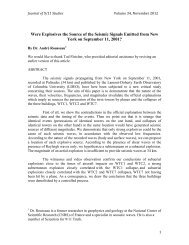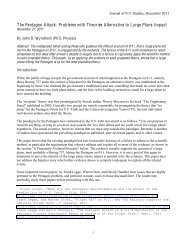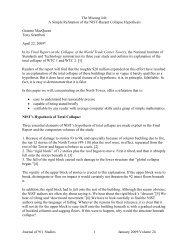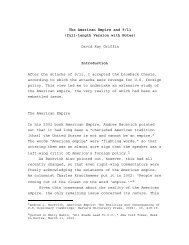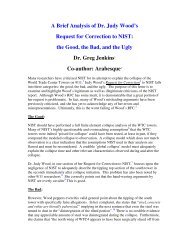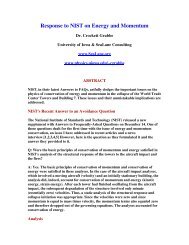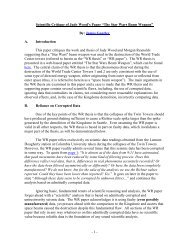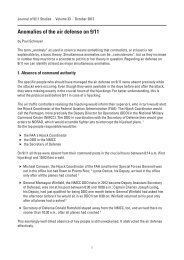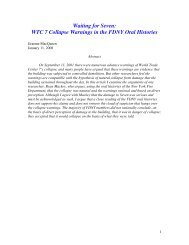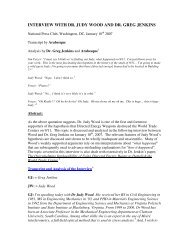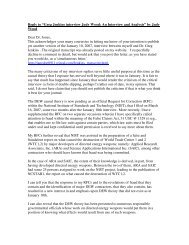Reply to Dr. Greening - Journal of 9/11 Studies
Reply to Dr. Greening - Journal of 9/11 Studies
Reply to Dr. Greening - Journal of 9/11 Studies
You also want an ePaper? Increase the reach of your titles
YUMPU automatically turns print PDFs into web optimized ePapers that Google loves.
manner at the collapse front. It does not cause predamage as <strong>Dr</strong>. <strong>Greening</strong> points out, the strain<br />
energies <strong>of</strong> any damage are separately accounted. Being a kinetic energy it has the ability <strong>to</strong><br />
cause damage only upon deceleration.<br />
As energy consumption at the collapse front begins <strong>to</strong> exhaust the energy available <strong>to</strong> the<br />
crushing mass, it will decelerate <strong>to</strong> such an extent as <strong>to</strong> then allow the elastic strain in the<br />
columns <strong>to</strong> act upwards against the kinetic energy in the floors and columns. The inertia <strong>of</strong> these<br />
columns would continue the elastic deflection <strong>of</strong> lower s<strong>to</strong>reys, the kinetic energy will thus<br />
continue <strong>to</strong> spread downwards as the columns search for new equilibrium positions, and there<br />
would undoubtedly be a bounce and vibrations set up but with the opposing force now being<br />
reduced <strong>to</strong> only the static mass <strong>of</strong> the upper section, any possible return <strong>of</strong> kinetic energy from<br />
the lower s<strong>to</strong>reys back <strong>to</strong> the collision front will not result in continued compression but rather as<br />
a lifting <strong>of</strong> the upper section, an increase in potential energy.<br />
Concrete Pulverisation<br />
Concrete pulverisation was immaterial <strong>to</strong> the initial argument <strong>of</strong> whether the collapse<br />
would be arrested or continue. It was included as indicative <strong>of</strong> the energies required and showed<br />
the early arrest <strong>of</strong> the collapse, but if considered as zero the collapse would have been arrested<br />
within the next few tenths <strong>of</strong> a second as the strain energy requirements instead drained the<br />
energy supply <strong>of</strong> the impacting mass. I specifically chose the analysis by <strong>Dr</strong>. <strong>Greening</strong> so as <strong>to</strong><br />
avoid unnecessary debate on this important but not directly considered aspect.<br />
However, regarding <strong>Dr</strong>. <strong>Greening</strong>'s new analysis there are one or two points which are<br />
worth examining. The analysis using 5MPa and 8.5m/sec would use up 128 MJ for one floor,<br />
but an average collision would have 20 MPa and 35m/sec, so this would roughly give a <strong>to</strong>tal<br />
consumption for the pulverisation <strong>of</strong> concrete throughout the <strong>to</strong>wer <strong>of</strong> 220GJ.<br />
We know that the potential energy <strong>of</strong> the <strong>to</strong>wer was roughly 1000GJ. We also know that a<br />
momentum only analysis <strong>of</strong> a <strong>to</strong>wer <strong>of</strong> equal s<strong>to</strong>rey mass would give the collapse front<br />
progressing from initiation level <strong>to</strong> the ground level in just under 12 seconds and reaching a<br />
velocity <strong>of</strong> 52m/sec. This would give a remaining kinetic energy <strong>of</strong> 690 GJ using a mass <strong>of</strong> 510<br />
k<strong>to</strong>nnes. A similar analysis <strong>of</strong> a <strong>to</strong>wer whose mass more emulates the <strong>to</strong>wer would show 13.5<br />
seconds, reaching 46m/sec and having kinetic energy <strong>of</strong> 540GJ. To remove 220GJ from this<br />
figure in order <strong>to</strong> pulverise the concrete would leave only 320GJ and this would indicate a<br />
collapse front <strong>of</strong> 17.5 seconds taking in<strong>to</strong> regard only the energies consumed in momentum<br />
changes and in pulverisation <strong>of</strong> concrete. None <strong>of</strong> the energies required <strong>to</strong> dis<strong>to</strong>rt any <strong>of</strong> the steel<br />
structure, nor <strong>to</strong> pulverise the remainder <strong>of</strong> the <strong>to</strong>wer construction materials or contents, nor <strong>to</strong><br />
disperse the debris and dust, nor any <strong>of</strong> the other energy demands and sinks associated with the<br />
collapse, are included in this figure <strong>of</strong> 17.5 seconds, only the inherent momentum demands and<br />
the pulverisation <strong>of</strong> the concrete.<br />
Force Propagation<br />
It is noted that <strong>Dr</strong>. <strong>Greening</strong> accepts that the force will propagate ahead <strong>of</strong> the movement<br />
<strong>of</strong> the collapse front.<br />
<strong>Journal</strong> <strong>of</strong> 9/<strong>11</strong> <strong>Studies</strong> 16 August 2006/Volume 2



